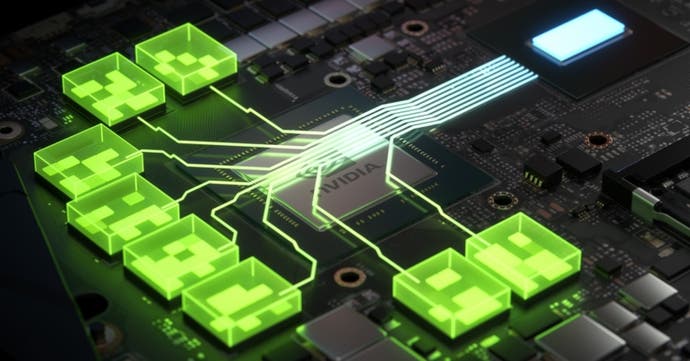Nvidia RTX 3060 review: Resizeable BAR testing
Boosted performance, on some games and platforms.
The RTX 3060 is the first desktop Nvidia graphics card to debut with PCI Express Resizeable BAR support, a technology that allows all video memory to be accessed directly rather than through a 256MB I/O buffer. This improved access can boost frame-rates substantially, but requires a relatively recent motherboard with a BIOS update to add the feature. For our testing, we're using a Z490 board, the Asus Maximus 12 Extreme.
AMD's Radeon 6000 series cards were the first to launch with Resizeable BAR support (where it was branded as 'Smart Access Memory'), where some games showed significant benefits and others ran more or less the same, so we were curious to see if we'd get similar results from Nvidia's first implementation on the RTX 3060. To find out, we tested with ReBAR on and off in three games: Battlefield 5, Metro Exodus and Watch Dogs Legion.
Battlefield 5
We tested Battlefield 5 first, and this game surprised us. We saw a 17 per cent improvement from toggling ReBAR on at 1080p, bringing the game from 117 to 137fps. The game is still highly playable either way, but this is certainly a noticeable difference if you have a monitor with a refresh rate of 144Hz or higher. The boost is muted slightly at 1440p, but it's still good for a healthy 15 per cent improvement. Even at 4K, an performance improvement of seven per cent is still quite significant, with the game running at 60fps for a greater proportion of the time.
Battlefield 5: DX12, Ultra, TAA
Metro Exodus
Metro Exodus also shows gains from having ReBar enabled, although the margin here is much narrower. 1080p results increase by three per cent, which drops to two per cent at 1440p and one per cent at 4K. It's possible that the game can take better advantage of the feature than the integrated benchmark can, but we unfortunately lacked the time to test this within the short review period. Regardless, you still get a measurable advantage here, within the same ballpark as minor system tuning like RAM overclocking, so opting for components with confirmed ReBAR support is still worth your time.
Metro Exodus: DX12, Ultra, TAA
Watch Dogs Legion
The most recent Watch Dogs title, Legion was co-developed with Nvidia engineers to add RTX and DLSS support - but does it take advantage of Resizeable BAR too? Our testing suggests it does see a healthy boost on systems with the feature enabled, with a five per cent advantage at 1080p that gives you some much-needed breathing room above that 60fps line. The effect is smaller but still measurable at 1440p, where we saw a 3.5 per cent improvement - although in real terms this corresponds to just a couple of extra frames per second. At 4K, Resizeable BAR seems to make little difference, with nigh-identical results recorded.
Watch Dogs Legion: DX12, Ultra, TAA
So in each of the three titles, we saw measurable advantages, with Battlefield 5 proving the best example of the feature and Metro Exodus the worst. As with the AMD cards we tested late last year, Resizeable BAR makes the biggest difference at 1080p and 1440p, with much less impact at 4K. That suggests that if you're gaming at these more mainstream resolutions, it's worthwhile to choose a motherboard which is confirmed to support the feature, while at 4K it's only really a 'nice to have'.
By the way, you might be wondering how we chose games to test ReBAR in - after all, Watch Dogs Legion isn't part of our normal test suite, and other mainstays like Assassins Creed Unity are absent. Well, Nvidia's graphics cards are confirmed to only use Resizeable BAR in a small set of games that have been shown to benefit from the technology. The upside of this is that you can leave the feature enabled on your motherboard without worrying about potential lost performance in some games, but it also means that you won't see any surprise wins in titles that might benefit but Nvidia hasn't whitelisted yet. As of the launch of the RTX 3060 in late February, eight games are supported, all of which use the DX12 API rather than alternatives like DX11 or Vulkan:
- Battlefield V
- Assassins Creed Valhalla
- Gears 5
- Borderlands 3
- Red Dead Redemption 2
- Metro Exodus
- Watch Dogs Legion
- Forza Horizon 4

It'll be interesting to see whether we see similar performance improvements on other RTX 30-series graphics cards when Resizeable BAR support is added to them too, which is reportedly happening via VBIOS updates from March onwards.
With the feature becoming more common on both AMD and Intel's latest motherboard platforms, all we really need at this stage is a greater number of whitelisted games that are proven to take advantage of the feature. We'll keep a close eye on this going forward, as at some point it may be sensible to start testing supported games with Resizeable BAR enabled in graphics card reviews like this one, once the feature becomes widely available.
Nvidia GeForce RTX 3060 Analysis
- Introduction and Hardware
- Doom Eternal, Control, Borderlands 3, Shadow of the Tomb Raider - Game Benchmarks Part 1
- Death Stranding, Far Cry 5, Hitman 2, Assassin's Creed Odyssey - Game Benchmarks Part 2
- Metro Exodus, Dirt Rally 2, Assassin's Creed Unity - Game Benchmarks Part 3
- RTX Game Benchmarks - Control, Metro Exodus, Battlefield 5
- Resizeable BAR Testing - Watch Dogs Legion, Battlefield 5, Metro Exodus [This Page]
- Nvidia GeForce RTX 3060 - the Digital Foundry verdict








